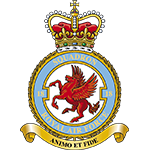RAF 222 (Natal) Squadron
Motto: Pambili Bo (Go straight ahead)
RNAS Unit in the Aegean, were allocated RAF squadron numbers but it would seem that these numbers did not really begin to be used until September, by which time movement and amalgamation of the original units led to some confusion. The number 222 was originally allocated to 'A' Squadron of No 2 Wing RNAS at Thasos, which was composed of DH4s and Camels. In June 1918 DH9 were added to its strength and when it adopted the number 222, it was sub-divided into Nos 478, 479 and 480 Flights. The squadron continued to carry out raids on Turkish targets in the Balkans until the end of the war, eventually disbanding on 27 February 1919.
The squadron reformed at Duxford on 5 October 1939 with Blenheims in the shipping protection role. However, this was soon changed and in March 1940, the squadron re-equipped with Spitfires. Two moths later it was covering the Dunkirk evacuation from Hornchurch before moving to Kirton-in-Lindsey in June. In August the squadron returned to Hornchurch to participate in the final stages of the Battle of Britain. It then followed the usual pattern for fighter squadrons, offensive sweeps from bases in the south interspersed with defensive duties in the North of England, East Anglia and Scotland.
In mid 1943, it was transferred to the 2nd Tactical Air Force, joining No 135 Airfield (later No 135 Wing). It now began carrying out offensive sweeps in preparation for the forthcoming invasion and during the invasion itself, provided air cover to the invasion convoys. The squadron moved onto the continent in late August to support the advancing armies through France and Belgium. However, in December 1944, the squadron was withdrawn from Belgium back to the UK, where it re-equipped with Tempests. These were then taken back to the continent in February 1945 with 222 continuing its moves eastwards until the end of the war.
The following month (June1945), the squadron returned to the UK again to re-equip, this time with Gloster Meteor jets fighters, which began to arrive in October. It moved around a number of bases including, Exeter, Weston Zoyland, Tangmere and Waterbeach until arriving at Leuchars in May 1950, where it remained until disbanding on 1 November 1957. Before disbanding it operated three versions of the Meteor, converted to the Hunter F Mk 1 in December 1954 and the Hunter F Mk 4 in August 1956. It had one final incarnation, which lasted from 1 May 1960 until 30 June 1964, as a Bloodhound Mk 1 surface-to-air missile unit at Woodhall Spa.
Squadron Codes used:
UP Allocated Apr 1939 - Sep 1939
ZD Oct 1939 - 1953

 Editor for Asisbiz: Matthew Laird Acred
Editor for Asisbiz: Matthew Laird Acred
If you love our website please subscribe to our YouTube video channel
Please donate so we can make this site even better !!

